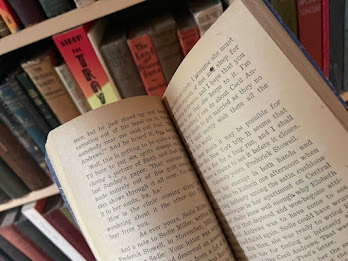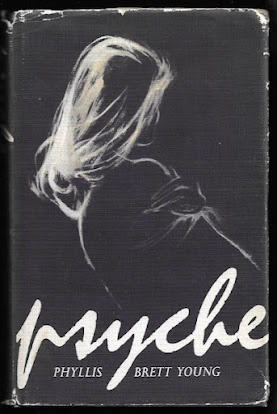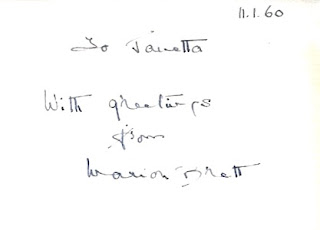Am I right that 'A New England Thanksgiving' ranks amongst Bliss Carman's better-known poems? Whatever the case, I'm pretty sure it's more familiar than 'A Thanksgiving.' This version is found in Last Songs from Vagabondia (Boston: Small, Maynard, 1900), Carman's final collaboration with American poet Richard Hovey. I quite like it.
09 October 2022
Bliss Carman's Lesser-Known Thanksgiving Poem
01 October 2022
Edna Jaques' Creeping October
For the new month, 'October' by Poet Laureate of the Home Edna Jaques. This version is taken from her 1946 Thomas Allen collection Back-Door Neighbors.
'Old Lady Christmas Shopping' by Edna Jaques
'A Mother at Christmas' by Edna Jaques
A Poet Laureate's 'Prayer for the New Year'
19 September 2022
Martha Ostenso's Forgotten Masterpiece?
Martha Ostenso
Toronto: News Stand Library, 1949
159 pages
The town is Bloomhill; the talk is of Elsbeth Payson. A few days before her eighteenth birthday, young Doctor Frederick Stowell catches Elsbeth at the Van der Water house. Priscilla Van der Water, a former "acrobatic dancer" now married to a brickyard foreman, is giving the girl a lesson on how to do a split. Stowell is horrified; Elsbeth lives in wealthy North Hill, and girls from North Hill do not visit Patchtown, Bloomhill's working class neighbourhood. The doctor orders her away, but she stands her ground: "Did you know, Freddie, that even for classical or professional ballroom dancing you should be able to do what's known as a 'split'?"
Elsbeth Payson's dream is to become a professional dancer. Her late mother approved, which is how she came to know Priscilla Van der Water in the first place. Her father, also late, looked to set his daughter off on a more conventional path, and so left almost everything to his two spinster sisters.
Almost everything.
On her birthday, Elsbeth is due to receive an inheritance of three thousand dollars (roughly $68,350 today). She intends to take the money, travel to New York, and study dance. A long-held plan, it comes off almost as Elsbeth had always envisioned, except that she's accompanied by pregnant Patchtowner Sadie Miller, whose fiancé was killed in one of Bloomhill's frequent industrial accidents.
Spanning 1933 and 1936, And the Town Talked is a Depression-era novel. I was interested in tensions between Bloomhill's classes, particularly after reading this early passage:
But And the Town Talked isn't much concerned with the plight of the proletariat. Though treated with sympathy, they're all pretty much the same: hard-working, cheerful, largely content with their lot in life. The exception is bad boy Cecil Andrews, who left Bloomhill's Patchtown for a life as a professional musician. He's a complex character, but only in relation to the others – Elspeth included.
And the Town Talked first appeared, marginally longer, in the February 1938 edition of McCall's.* Later that same year, Ostenso published Mandrake Root, which was subsequently translated to Norwegian, Hungarian, and Czech. Other novels followed: Love Passed This Way (1942), O River, Remember! (1943), Milk Route (1948), The Sunset Tree (1949). Her last book has my favourite title: A Man Had Tall Sons (1958). All were published by Dodd, Mead, but not And the Town Talked, which somehow ended up with a cheap paperback house located in the suburbs of Toronto, and is missing from nearly all her bibliographies.
Is And the Town Talked a masterpiece, as News Stand Library claims? Most certainly not!
Is Wild Geese a masterpiece, as academics have claimed? Here's hoping.
I'm moving my copy to the night table.
* Thanks to bowdler of Fly-by-Night, who spared me the task of comparing the McCall's and News Stand Library versions. His finding is that the latter cut short four of the novel's twenty-two chapters.
Object: A typical News Stand Library production, meaning that there is certain to be some sort of flaw. In this case, centre margins are so tight as to make it nearly impossible to read.
My copy was purchased earlier this year. Price: C$60.
The cover – uncredited – misleads in that Elsbeth has no child. Is she babysitting? Or is that meant to be minor character Sadie Miller?
14 September 2022
Born Again Infidel
419 pages
"Not guilty, your honor!"
After returning to his office, Charley considers his victory:
"I was dull, blank, all iron and ice; the judge, the jury, the public, even Kathleen, against me; and then that bottle in there — and I saw things like crystal! I had a glow in my brain, I had a tinge in my fingers; and I had success, and” — his face clouded — “he was as guilty as hell!”
In other words, Kathleen is a trophy wife.
Badly beaten, he's thrown into the St Lawrence, only to be pulled onto a raft piloted by the very man who's acquittal features on the novel's first page. The two drift eastward toward the outskirts of the town of Chaudiere, at which the supposed murderer – “he was as guilty as hell!” – has a lonely cabin. Charley is nursed back to physical but not mental health. A head wound has left him as a child. He remembers nothing of his past and lives each day as something of an innocent, until operated on by a "great Parisian surgeon," who happens to be visiting his brother, the local curé.
Charley faces a dilemma:
What was there to do? Go back? Go back and knock at Kathleen’s door, another Enoch Arden, and say, "I have come to my own again”? Return and tell Tom Fairing to go his way and show his face no more? Break up this union, this marriage of love in which these two rejoiced? Summon Kathleen out of her illegal intercourse with the man who had been true to her all these years?
And make no mistake, The Right of Way is a Victorian novel. What's more, it was a popular Victorian novel, bringing with it coincidence and contrivance. Sleepwalking does figure. It is a fever fantasy about a man who is given a second chance at life. For it to work, the reader must believe that Charley not only acknowledges his wrongs, but cares so much for Kathleen, a woman he never loved, that he cannot return to reclaim his wealth and his social standing.
Trivia III: The Right of Way was adapted for the stage (1907) and twice to the silent screen (1915 and 1920). Both films are lost. In 1931, it returned to the screen as a talkie. In this clip Loretta Young (Rosalie) and Fred Kohler (Jo, the murderer) bravely attempt French Canadian accents.
Online prices range from US$1.89 to US$185.01. As expected, there's nothing at all special about the most expensive, a Grosset & Dunlap reprint lacking jacket. A New York bookseller lists the 1931 Grosset & Dunlap photoplay edition for US$76.00. The most intriguing is a Nelson Library edition "in RARE Color DustJacket of Dead Man on Floor & Woman Kneeling with Apron, Holding Back a Large Brown Dog with Sharp Teeth," offered at US$60.00 by a California bookseller. Something similar does feature in the novel, but the scene is inconsequential (and the man involved isn't dead).
Several editions are available for download at the Internet Archive.
06 September 2022
The Dustiest Bookcase: Y is for Young
Phyllis Brett Young
Toronto: Longmans, Green, 1959
319 pages
Psyche was Phyllis Brett Young's first book. My copy, signed by the author and inscribed by her mother, was purchased two years ago for £20 from a bookseller in Wallingford, UK. It should have cost me a small fortune.
The story of a lost local literary gem, lost and foundMcGill-Queen's reissued Psyche the following year.
The author's three remaining books – Anything Could Happen! (1961), Undine (1964), and A Question of Judgement (1969) – have now been out of print for more than a half-century.
In a country plagued by indifference regarding its literary heritage, Phyllis Brett Young remains the most unjustly neglected writer.
 |
| Phyllis Brett Young 1914 - 1996 RIP |
























